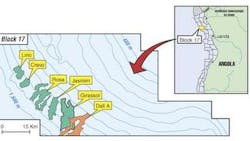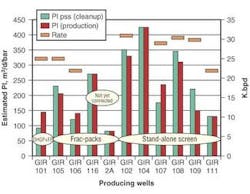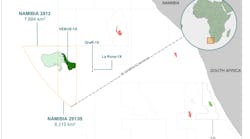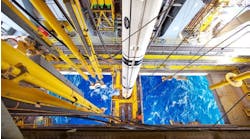Eric Delattre
Emmanuel Mus
Nicolas Payer
Total
Mark Van Domelen
Alfred Azer
Halliburton
Cased-hole completions with frac packs have proven to be relatively simple and low-risk options and have shown good production performance with no screen plugging or production falloff in develop-ment wells in the Girassol field offshore Angola.
The frac pack solution was chosen to prevent sand production. To date, no sign of sand production has been noticed in the production loop. In addition, the frac pack is currently the technique that provides the best skin results for the reservoir conditions.
The Girassol field was discovered in May 1996 with the GIR-1 well and appraised in 1997 with two additional wells. The field is in block 17, located offshore Angola, 210 km northwest of Luanda, and in water from 1,250 to 1,400 m. Girassol is one of several fields in this prolific block.
The two-phase Girassol development plan is based on 39 subsea wells: 23 oil producers, 14 water injectors, and two gas injectors. The first phase, completed in December 2001, includes eight oil producers, two water injectors, and one gas injector. The development plan is a full subsea development tied back to a spread-moored FPSO unit.
All reservoirs in the field are constituted of highly unconsolidated sands, which require the wells to be completed with sand-control techniques. The wells have high productivity, up to 40,000 b/d of oil because of the excellent reservoir characteristics. Pressure maintenance of the field will be achieved with seawater injection and reinjection of produced gas for a limited time. The variations expected in sand qualities and reservoir configurations indicated that more than one completion method would likely be required.
Reservoir description
Reservoir characteristics are well known from extensive wireline logging programs and associated coring acquisition on first-development wells. Fine to medium sands, generally well sorted, have very good porosity (30 to 40%) and good permeability (K~ 1 to 5 darcy). Medium to coarse sands have good porosity (20 to 30%) and very good permeability (3 to 10 d). Very coarse sands and conglomerates have fair porosity (15 to 20%) and fair permeability (100 md to 1 d). Reservoir temperature ranges between 140° and 160° F.
The Girassol sand is poorly sorted as indicated by sieve analysis conducted on B3 samples, with sizes ranging from fine to coarse. Sand is sometimes laminated with shales. On tested samples, the content of silica material is high (more than 80% by weight) with minor feldspar (generally <10% weight). The clay content is low (commonly <5% weight), with kaolinite being the dominant clay mineral.
Based on reservoir descriptions, the finest sands appear to be located at the top of the sand bodies. Vertical distribution of the sand bodies cannot be predicted accurately with the current reservoir knowledge. The sand bodies have also a limited lateral extent. The lateral extent of the shale layers is one of the major uncertainties of the field.
The Girassol field is in block 17 offshore Angola 210 km northwest of Luanda in 1,250 to 1,400 m of water.
Development wells definitely cut through shales in the reservoir. Net-to-gross ratio is 40 to 50% for vertical/deviated wells with shale sections 10 to 20 m thick (vertical). Higher net-to-gross ratios can be achieved on horizontal or high-angle wells (50 to 70%) provided that the drains can be adequately placed.
Completion evaluation
When planning for the completions on Girassol, the industry already had significant experience with various types of sand-control completions. The projects with reservoir conditions that most closely resembled Girassol, such as Hoover/Diana and Troika fields in the Gulf of Mex-ico, both successfully employed cased-hole completions (with frac packs) as part of their development plan.
Sand control is a major driver in the design of both the sand face and the overall well architecture. The ambitious productivity objectives made sand-control engineering a critical issue.
Completion experience from the exploration and early development wells provided valuable information for the development-phase implementation.
During the exploration phase on block 17, several sand-control techniques were performed for well testing, including screen alone in cased hole, stand-alone screen in open hole, acid prepack, high-rate water packs (HRWPs), frac packs, expandable screens in open hole, and openhole gravel packs (OHGPs). Of the techniques, HRWPs were the most commonly used.
Sixteen wells were tested during exploration. In most cases, only one interval was to be tested to obtain data for prospect assessment purposes. To achieve good isolation of the level to be tested, a cased hole completion had to be used, thus the HRWP was the most appropriate technique.
With these completions, the productivity indexes obtained were generally low and the applied difference between the shut-in pressures and flowing pressures were high to get a valid assessment of the productivity and of the formation characteristics. The skins obtained were generally high, but were low in some cases. The average skin obtained was 15.
The frac-pack technique was used on one of the exploration wells to validate the concept to be applied on Girassol. A low skin of -0.5 was achieved for a final productivity index of 40 cu m/d/b on an interval of 7 m with a mobility (Kh/µ) of 21,000 mD-ft/cP. This experience provided valuable information and confidence in the technique for Girassol development-phase implementation.
Oil producers
Girassol development wells use two completion techniques for oil producers – openhole with screen alone in horizontal wells and cased-hole frac-pack completions in low-angle wells. Grain sizes vary widely along the 12 facies types identified in the Girassol Oligocene reservoirs, from very fine (less than 80 microns) to very coarse (centimetric).
Extensive laboratory work and studies were conducted to qualify screens for open hole completions. Screen-only techniques were concluded unsuitable for the finer sands, but had to be dedicated to a limited range of facies. Wire-wrapped screens were selected because of their "self-cleaning" capability when compared to premium screens, and slot sizes were optimized from laboratory testing with representative samples of the finer allowable facies.
Completion of horizontal or high-angle wells with wire-wrapped screens should be dedicated to suitable facies. Well planning requires close cooperation between the geoscientists, geologists, and drilling and the completion/sand-control engineers. Horizontal drains are typically 500 to 1,000 m long and are completed with 6 5/8-in. screens to limit friction pressures in the screen base pipe, allowing flow contribution from the far end of the drain. A 9 1/2-in. open hole with 10 3/4-in. production casing was preferred for this size screen to increase annulus clearance and to facilitate installation in the 3D well paths.
A 9 5/8-in. cased-hole frac-packed (CHFP) completion is preferred where:
- Several stacked sequences need to be drained on a single well
- Finer facies are the main target
- Laminated sands with low net-to-gross are expected.
Cased hole completion
At the onset of the development project, industry experience with cased hole completions in high-mobility reservoirs (greater than 60,000 mD-ft/cP) was limited. Although the projects in the comparable deepwater fields did show good results with CHFP completions, many in the industry still questioned the ability to efficiently place the frac packs and to produce these wells at high flow rates without seeing turbulent skin effects.
The perforation design for Girassol 105, 106, 116, and 2A wells used tubing-conveyed perforation 7-in. big-hole low-debris charges with perforation lengths limited to 40 m/zone. A viscous pill, hydroxyethyl cellulose, was placed 100 m above the perforations before the gun was fired to avoid heavy losses. Perforations were shot with 10 bars overbalance.
The bottomhole assembly consisted of 5 1/2-in., 15.5-lb wire-wrapped screens, slot 12. A very short gravel pack assembly system was designed for stacking two frac packs with the minimum interval between them. A weight-down system and a live annulus are mandatory to perform frac packs on a floater.
For this project, a 30-lb/Mgal borate-crosslinked fluid was used for the frac packs. It provided fluid efficiencies in the range of 15 to 25%, which was more than adequate for placement of the desired proppant volumes.
Lightweight ceramic 20/40 and 16/20 gravels were used on Girassol completions. The gravel selection depended on the type of reservoir encountered; 16/20 was mainly used on the B3 and B2 channels, and 20/40 was used on the B1 channel.
Frac packs were performed in 9 5/8-in., 47 lb/ft casing, while a contingency existed to complete wells in 7-in., 29 lb/ft liner.
Initially, the development plan was based on conventional wells. Very quickly it became clear that horizontal producers were adapted to Girassol and could yield significant savings in the development. However, conventional wells were not completely discarded from the development because in some areas, targeting stacked reservoirs was necessary. Five conventional producers have so far been developed for a total of 10 producers drilled and completed.
The well performances – productivity indexes and flow rates – of all 11 development wells.
null
Currently, four of the eleven development wells in this field are cased hole completions using frac packs, with GIR 101 a combination of OHGP and CHFP in two zones. The remaining wells are open hole stand-alone screens.
The sand-grain size distribution was not always favorable to stand-alone screen or OHGP completions. This is particularly true for the lower sequences of the reservoirs. With a fair amount of oil volume located in these reservoirs, a solution that allowed efficient control of the thin grain sands had to be implemented.
The frac pack was retained as the solution to prevent sand production in these reservoir levels. To date, no sign of sand production has been noticed in the production loop. In addition, the frac pack is currently the technique that provides the best skin results for these reservoir conditions.
From the experience gained on the exploration wells and on the first development wells, the range of skin factors that can be obtained from the frac packs has been lower than the OHGP completion. A simple productivity index estimation was conducted on that basis to demonstrate the viability of the frac-pack technique. The results show that depending on the reservoir configuration, the frac-pack option in cased and perforated wells provides satisfactory performances under these reservoir conditions.
Analysis of the Girassol field data indicated:
- Both cased hole and open hole completions have been used in this field to date. The cased hole completions have employed frac packs, and the open hole completions have employed screen-only techniques
- Low skins and high productivity indexes have been observed on most of the Girassol wells, with the cased hole completions showing comparable results to the open hole completions. Fluid mobilities have ranged from 50,000 to 350,000 md-ft/cP
- Although an initial concern, turbulent skin effects have not been observed for the cased hole completions, even at oil flow rates in excess of 25,000 b/d from relatively small intervals
- The frac-pack designs have focused on maximizing fracture conductivity through TSO designs, maximum proppant sizing, and aggressive breaker loadings. Perforating performance has been effective through the use of high shot density, bottomhole charges, and prejob acid squeeze treatments
- The cased hole completions have proven to be relatively simple and low-risk and have shown good production performance to date with no screen plugging or production falloff
- Best practices continue to evolve as more experience is obtained with completions in the Girassol field.
Acknowledgements
The authors thank Total, Halliburton, and Sonangol for their support and permission to publish this paper.
Editor's Note: This is a summary of SPE 78322.





